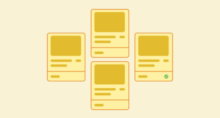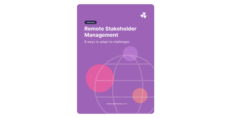7 Hidden Costs When You Don’t Have Stakeholder Software

Considering the pros and cons of investing in stakeholder software like Simply Stakeholders?
Some of the reasons to use stakeholder management software are obvious, but some are much less obvious. And although there’s a monetary price to pay when you sign up for stakeholder management tools, there are also many hidden costs that organizations pay when they don’t use stakeholder management software.
It’s really important to factor these costs into your decision. So, we wanted to shine the light on 7 hidden costs your business might be paying until you invest in stakeholder software.
Seven Hidden Costs of Not Using Stakeholder Software
1. Continually Reinventing the Wheel
There are many compelling reasons why stakeholder relationship engagement software does the job a lot better than an Excel spreadsheet or a CRM system. But one of them is that it is designed for stakeholder management, and keeping stakeholder-related information well organized and easy to access. You can quickly open it up, enter/view information in the right place, and get on with your work.
Learn more about why you should leave spreadsheets behind.
But with a spreadsheet, your team will likely find themselves continually ‘reinventing the wheel’. They’ll likely end up creating (and juggling) multiple spreadsheets, with each person taking a slightly different approach to recording stakeholder data and issues lists. Even if you use a CRM to manage stakeholder data, you’ll need to implement various workarounds to adapt it to your needs, which can get complex and confusing for your team members.
Of course, this leads to a whole other set of challenges and costs…
2. Wasting Time (and Money)
When you’re working with old-school, paper-based systems (or even digital spreadsheet software), your data will likely be handled multiple times, which increases the risk of inaccuracies and becomes very inefficient.
Your senior resources will waste a significant amount of time manipulating the data instead of focusing on interpreting it (which is where the real value lies). They may spend weeks creating their reports manually. And of course, all this time adds up to significant staffing costs.
On the other hand, with stakeholder software, they could enter the data once, and produce a report in a matter of minutes!
3. Taking on More Risk

When considering the cost and ROI of stakeholder software, risk is an important consideration (as you can see in the above diagram).
Without stakeholder engagement software, you cannot easily and quickly demonstrate compliance and provide evidence for any audits and legal challenges. And of course, your consultation processes themselves may be less rigorous, leaving you open to greater reputational risk and a higher chance of legal reviews and challenges. These can lead to very real out-of-pocket costs and delays.
On the other hand, implementing stakeholder software can help you:
- Increase clarity and transparency around stakeholders
- Identify stakeholders’ level of interest, impact, and influence on projects (to recognize risks before they occur)
- Keep data and findings from the whole team in one place and always up-to-date
- Improve information management and tracking
- Always be ready for potential audits or legal issues
4. Missing Important Conversations
Today, there are more communication channels than ever and it’s likely that your organization needs to be across them all. This means tracking conversations and reporting on activity from all channels, whether it’s social media, emails, phone calls, face-to-face events, surveys, discussion forums, or something else.
Without stakeholder software that integrates with all your platforms, it’s almost certain that you’ll miss important conversations, the opportunity to be part of those conversations, and the topics and issues being discussed. As a result, you might end up focusing on issues that aren’t actually important to your stakeholders because you won’t have that data. This could cost you:
- The ability to connect with people in a meaningful way
- The accuracy of your report findings
- The overall impact and effectiveness of your project or organization
- Time and resources spent focusing on the wrong thing
5. Less Frequent Engagement
Without stakeholder software, you’ll probably find that even the simplest engagement tasks take a lot of time. For example, sending a letter, requesting stakeholder input via a survey, or figuring out who you need to engage with next. And you’ll find it difficult to measure the impact of any engagement tasks you do undertake.
This means that you’ll probably reduce the frequency of your engagement. And if you’re not interacting with stakeholders on a regular basis, you may struggle to achieve your goals.
6. Inconsistent and Ineffective Engagement
If you’re not tracking your stakeholders and consultation activities in stakeholder software, you’ll probably be a lot less consistent and effective in your engagement. That could be because of several reasons, like:
- Difficulty tracking who you’ve engaged with and what their response has been
- Difficulty reporting on how feedback is impacting decisions
- Difficulty targeting communications to specific stakeholder segments
7. Knowledge Not Captured

Every consultation has the potential to produce a huge amount of data. Some of that data will likely be very useful for both current and future projects — if you can capture it and get it into a usable format.
This becomes a near-impossible task without stakeholder software. Instead, if your key staff leave, the stakeholder intelligence they gathered tends to leave with them. Or any stakeholder data you do have is tucked away in various emails, documents, and spreadsheets.
But if you have stakeholder software, your data is always where it’s meant to be, easily accessible, up-to-date, and in a standardized format (so you can easily pull insights and reports). This enables you to gain a number of benefits that are linked to strategic, long-term goals (as you can see in the above diagram).
It means you can:
- Build better relationships with stakeholders (over a longer period of time)
- Evaluate your consultation to improve your processes
- Get so much more value from stakeholder data
- Turn your data into a wealth of knowledge for your organization that future teams and projects can leverage
Do Any Of These Costs Apply To You?

If you’re considering the cost of stakeholder software, make sure you’re also considering the above costs of not using it.
Comparing your options? Simply Stakeholders is a stakeholder management tool that can help your team reduce their costs, improve their processes, and manage risk. Best of all, it’s user-friendly and easy to implement, so you can start seeing benefits (and cut down on those hidden costs!) right away.
Learn more about our stakeholder software or get in touch with our team to book a demo or find out more about the product.



































